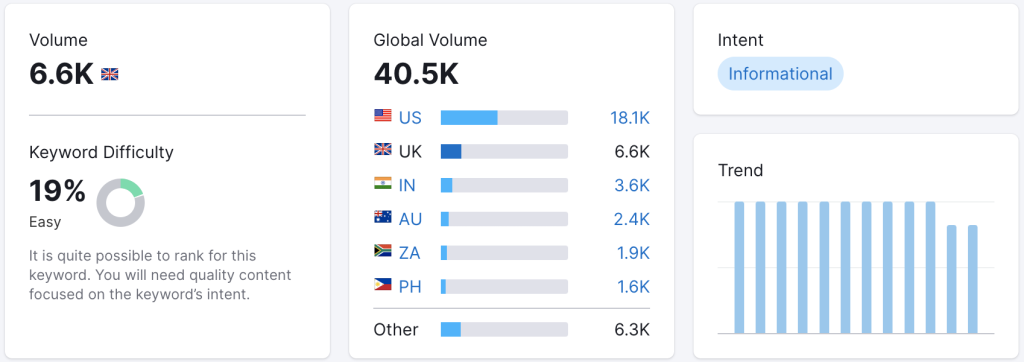When creating content, whether it be for a product, category, blog or any other landing page, you should always identify the keyword that you want the page to rank for. At Proof3, we have access to several keyword research tools that will help us determine the best match for your content.
When choosing keywords, we will consider elements like relevance, search volume and level of difficulty to rank for the keyword. Once we’ve identified what we want the page to rank for, we will integrate the keyword and its variations throughout the content in a way that reads naturally.
As stated in the previous section, it’s important to integrate keywords in a way that reads naturally for users, as Google favours it above content written for search engines. Not only will it increase your chances of ranking higher, but it also ensures that users spend more time on your site.
To write content for users, you should:
Ensure it answers user intent.
Align your content with what your target audiences want to see.
Ensure that your content is easy to read, well-structured and visually appealing.
Be optimised for mobile.
User intent refers to the reason behind why users are searching. Intent is categorised as:
Navigational intent: The user wants to navigate to a particular website or page. If someone searched for ‘Facebook login’, they would expect to see results where they could directly login to their Facebook account.
Informational intent: Users are seeking information and could include searches for terms like ‘how-to’ and ‘what is’.
Commercial intent: The user is interested in a product or service, but they are still making a decision. We often see comparison searches like ‘best hypoallergenic dog food’ or ‘TV reviews’.
Transactional intent: Users know that they want to buy a product or service. You will often see specific transactional searches like ‘buy iPhone online’ for example.
It’s important to ensure that you identify the intent of your keyword to increase the content relevance. For example, when searching for ‘puppy food’ in SEMrush, you can see that the keyword intent is informational. This indicates that we should either create an in-depth blog to support the puppy food category or product pages, or we should add FAQs to cover the most relevant questions around the term.

Updating underperforming or outdated content is another way to easily help your content perform better in the SERP. By creating content that is up-to-date, relevant and accurate, you can improve its visibility and drive more organic traffic to your website. If you’d like our SEO team to review your content, providing actionable tips and recommendations to improve its performance, drop us a line.
Although we have heavily focused on ensuring that you write content for users, it’s also important to remember search engine optimisation (SEO). By this, we mean ensuring that you’re using the correct heading structure, you’re using internal and external links in your content and you’re optimising images with alt tags, as well as everything else we’ve mentioned in the previous sections.
It’s also important to ensure that you optimise your on-page metadata, such as creating unique and descriptive SEO titles and meta descriptions that contain the target keywords. By ensuring that you efficiently optimise for search engines, you can increase your content’s visibility, accessibility and rankings.
Remember: Always optimise for the user first, without neglecting SEO.
Site speed is extremely important when it comes to performance. According to Think with Google, 53% of users will abandon a site that takes longer than 3 seconds to load. That’s a lot of traffic.

Slow sites indicate to search engines that users aren’t finding the information they’re looking for, and they might show your competitors above your content because their website loads faster.
The bottom line is, if your website loads fast, users will have a better website experience, they’ll stay on your site longer and they’ll likely convert. To improve your website speed, consider the following:
Optimise image sizes.
Minify CSS and JavaScript files.
Use caching to store static files and reduce server response time.
Choose a reliable hosting provider.
Test your website’s speed using tools like Google PageSpeed Insights or contact us.
Optimising for mobile devices can also help your performance by increasing user engagement, reducing bounce rates and, ultimately, increasing your website’s overall success in the SERPs.
Here are some ways that you can ensure that your site is optimised for mobile:
Ensure that users can easily navigate your site on smaller mobile devices.
Test how your website looks on different mobile devices.
Use a mobile-friendly design.
Backlinks are links from external sites that link back to your site. Google uses these backlinks as a signal of your content’s relevance, and the higher the quality of the backlink source, the more Google will favour your content.
An example of a high-quality backlink would be a link from local councils for a business that specialises in irrigation supplies.
Here are some techniques for acquiring high-quality backlinks:
Create valuable and shareable content.
Establish relationships with industry influencers or thought leaders.
Use other channels like social media to encourage people to share and link to your content.
Identify opportunities where external sources are mentioning your brand name, without including a link. Get in touch with our SEO team if you’d like help identifying these missing backlink opportunities.
Once you have strategies in place to improve your content’s performance, it’s important to use analytics tools to track and monitor your content’s performance. By regularly monitoring how users are interacting with your content, you can better make data-driven decisions to continuously improve your performance and ROI. The metrics that we recommend for tracking and monitoring content performance include:
Traffic
Impressions
Click-through rate (CTR)
Keyword rankings
Backlinks
Conversions
Bounce rates
There are many ways to ensure that your content has a better chance of ranking in the SERPs. At Proof3, our SEO team can help you analyse your content’s performance to identify areas of your website’s content that might not be performing to expectation. We will then conduct research and provide actionable recommendations to help improve your content. If you want us to help with improving the content on your site to rank higher for organic search, drop us a lin
